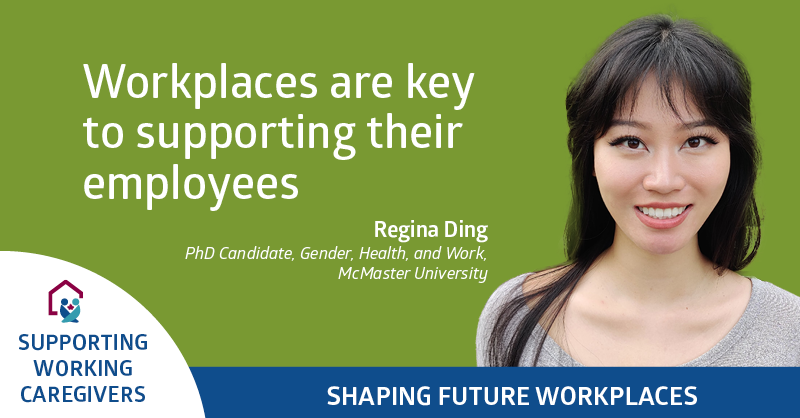Does educating working caregivers save employer costs?
In our six-month study we found mixed evidence about the cost-savings, where costs were increased in some areas and saved in others. Cost savings are but one piece of the puzzle and not always the end goal of intervention programs.
Workplaces are key agents in supporting (or hindering) their employees in achieving personal balance between work and caregiving. Despite the growing evidence that asserts the business case for workplace support of carer-employees (CEs), economic estimates are sparse. It was previously found that workplaces may expect to lose $8,674 per CE, if the CE is unsupported by the workplace.[i]
However, COVID-19 has changed the dynamics of both work and caregiving. In a soon to be published paper, we describe our study that assessed the cost-implications of a workplace intervention to generate carer friendly workplace culture change. This study was implemented in a large engineering company during COVID-19.
The intent of the study was to determine if the workplace intervention was cost-saving in the short-term by assessing the following questions:
- Does the intervention avert costs (absenteeism, presenteeism, turnover, and impact to coworkers) for the employer?
- Do these averted costs outweigh the implementation costs of the intervention?
The approach was to monetize workplace caregiving-specific absenteeism, presenteeism, turnover, and caregiving impact on colleagues, and examine changes in these costs over time. A conservative approach of assuming the lower end of estimates was taken and not all costs/benefits, such as employee wellbeing and satisfaction, were monetized.
Costs were evaluated from the employer’s perspective, in the no intervention scenario (pre-test) versus the post-intervention scenario (post-test) over a 6-month period. Costs savings refer to the difference in cost between the two scenarios, with the assumption that this difference did not change during our observational window. Pre-test data is assumed as the baseline for comparison. Averted costs refer to the reduction in cost (immediately) after the intervention. Future averted costs were not measured due to the short timeframe (six months). A net cost analysis was done by subtracting the implementation costs of the intervention from the averted costs.
The intervention was not effective at averting costs and did not pay for itself within the six month intervention period. However, there were cost savings in both short-term and long-term absenteeism. These savings, however, are negated by increased expenses in other cost categories, such as presenteeism, turnover, and impact on colleagues.
Subsidiary findings of interest were that turnover intention was higher among CEs than non-CEs and, given alignment to the larger literature, may forecast a concerning trend for workplaces. The high presenteeism cost may have reflected that the workplace was operating under a work-from-home mandate due to COVID-19 and may have made up time during “off-hours”.
While the results are mixed, this research holds implications for studies with a longer observational period and greater number of participants. It is important to note that cost-savings are not always the end goal; perhaps an investment in carer-employees is what’s needed to maintain a high performing workplace.
References
[i] Mofidi, A., Tompa, E., Williams, A., Yazdani, A., Lero, D., & Mortazavi, S. B. (2019). Impact of a caregiver-friendly workplace policies intervention: a prospective economic evaluation. Journal of occupational and environmental medicine, 61(6), 461-468.
ABOUT THE PROJECT
Carers Canada is leading the knowledge mobilization activities for a multi-sectorial research program to spread and scale a carer-friendly workplace standard, known as the Carer-Inclusive and Accommodating Organizations’ Standard (CSAB701-17). Led by Dr. Allison Williams, CIHR Research Chair in Gender, Work and Health at McMaster University, the research program consists of six inter-related sub-projects that will: increase awareness of the standard across Canada; evaluate readiness to change; determine feasibility and cost benefit; embrace cultural competency; consider Indigenous perspectives; and create an international standard. Visit PARTNERSHIP PROJECT SITE here

CIHR/SSHRC Healthy Productive Work Partnership Grant “Scaling up the Career Inclusive Accommodating Organizations Standard” FRN: HWP-146001 (CIHR); 890-2016-3018 (SSHRC).
 Regina DingFebruary 10, 2022
Regina DingFebruary 10, 2022

Does educating working caregivers save employer costs?
Workplaces are key agents in supporting (or hindering) their employees in achieving personal balance between work and caregiving. Despite the growing evidence that asserts the business case for workplace support of carer-employees (CEs), economic estimates are sparse. It was previously found that workplaces may expect to lose $8,674 per CE, if the CE is unsupported by the workplace.[i]
However, COVID-19 has changed the dynamics of both work and caregiving. In a soon to be published paper, we describe our study that assessed the cost-implications of a workplace intervention to generate carer friendly workplace culture change. This study was implemented in a large engineering company during COVID-19.
The intent of the study was to determine if the workplace intervention was cost-saving in the short-term by assessing the following questions:
- Does the intervention avert costs (absenteeism, presenteeism, turnover, and impact to coworkers) for the employer?
- Do these averted costs outweigh the implementation costs of the intervention?
The approach was to monetize workplace caregiving-specific absenteeism, presenteeism, turnover, and caregiving impact on colleagues, and examine changes in these costs over time. A conservative approach of assuming the lower end of estimates was taken and not all costs/benefits, such as employee wellbeing and satisfaction, were monetized.
Costs were evaluated from the employer’s perspective, in the no intervention scenario (pre-test) versus the post-intervention scenario (post-test) over a 6-month period. Costs savings refer to the difference in cost between the two scenarios, with the assumption that this difference did not change during our observational window. Pre-test data is assumed as the baseline for comparison. Averted costs refer to the reduction in cost (immediately) after the intervention. Future averted costs were not measured due to the short timeframe (six months). A net cost analysis was done by subtracting the implementation costs of the intervention from the averted costs.
The intervention was not effective at averting costs and did not pay for itself within the six month intervention period. However, there were cost savings in both short-term and long-term absenteeism. These savings, however, are negated by increased expenses in other cost categories, such as presenteeism, turnover, and impact on colleagues.
Subsidiary findings of interest were that turnover intention was higher among CEs than non-CEs and, given alignment to the larger literature, may forecast a concerning trend for workplaces. The high presenteeism cost may have reflected that the workplace was operating under a work-from-home mandate due to COVID-19 and may have made up time during “off-hours”.
While the results are mixed, this research holds implications for studies with a longer observational period and greater number of participants. It is important to note that cost-savings are not always the end goal; perhaps an investment in carer-employees is what’s needed to maintain a high performing workplace.
Once published, a link to the paper will be posted.
References
[i] Mofidi, A., Tompa, E., Williams, A., Yazdani, A., Lero, D., & Mortazavi, S. B. (2019). Impact of a caregiver-friendly workplace policies intervention: a prospective economic evaluation. Journal of occupational and environmental medicine, 61(6), 461-468.
Regina is a final year PhD Candidate at McMaster University, researching population health and aging. Her dissertation focuses on the program evaluation of a workplace carer intervention for carers. Regina has an interdisciplinary background in life sciences and environmental sciences prior to her work at McMaster, although she has always been interested in knowledge translation and scientific policy.
FAVORITE PASTIME: Most recently, pottery.
Twitter: @DingRegina
LinkedIn: @regina-ding-b53b871a1
ABOUT THE PROJECT
Carers Canada is leading the knowledge mobilization activities for a multi-sectorial research program to spread and scale a carer-friendly workplace standard, known as the Carer-Inclusive and Accommodating Organizations’ Standard (CSAB701-17). Led by Dr. Allison Williams, CIHR Research Chair in Gender, Work and Health at McMaster University, the research program consists of six inter-related sub-projects that will: increase awareness of the standard across Canada; evaluate readiness to change; determine feasibility and cost benefit; embrace cultural competency; consider Indigenous perspectives; and create an international standard. Visit PARTNERSHIP PROJECT SITE here

CIHR/SSHRC Healthy Productive Work Partnership Grant “Scaling up the Career Inclusive Accommodating Organizations Standard” FRN: HWP-146001 (CIHR); 890-2016-3018 (SSHRC).